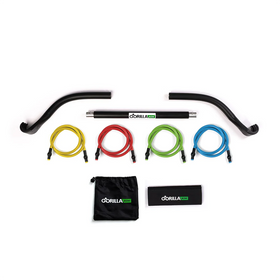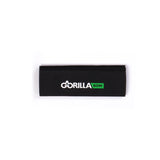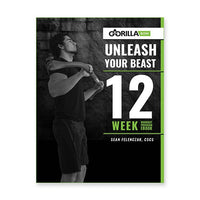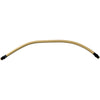Do This Rotator Cuff Warm Up To Prevent Injury

As much as we wish we could just grab our Gorilla Bows and start putting in the work, there’s a little bit of prep that needs to be done before a heavy workout. Particularly, you need to do a proper warm-up to ensure a safe and successful routine.
A good warm-up routine incorporates a lot of stretching so that your muscles are ready for whatever lies ahead. And before a big shoulder day, it’s especially important to get your shoulder joints loose and mobile.
If shoulder pain is getting in the way of your shoulder gains, this rotator cuff warm-up might be exactly what you need.
What Is a Rotator Cuff?
In case you forgot everything you learned in your middle school Bio class, we’ll give you a little refresher on everything you need to know about your rotator cuff. After all, what’s the point in stretching and bulking up your shoulders if you don’t even know what they’re made of?
Your shoulder is a ball and socket joint, meaning that your arm attaches into a socket in your shoulder. Ball and socket joints allow for greater freedom of movement than any other joint in the body. The only other place on your body where you have this type of joint is on your hips.
However, your bone needs something to attach to the inside of the socket. This is where the rotator cuff comes into play. It’s a group of four muscles that form a covering around the head of the humerus, which then attaches to your shoulder blade so that you can freely move your arm.
Importance of Stretching Your Rotator Cuff
Every workout needs to start with a good warm-up. Warming up is the act of physically increasing your heart rate so that your muscles are supplied with enough oxygen and energy to take on a heavy workout. While it’s important to incorporate dynamic movements into a warm-up, it’s also essential to throw in some stretches.
Stretching can help prevent muscle injury, and in the instance of your rotator cuff, this is extremely important. It’s estimated that just over 22% of people will experience a rotator cuff injury at some point in their lives. And you don’t want to become a part of this statistic.
Rotator cuff tears are extremely painful, and they can severely limit your ability to move properly. There are a few reasons why you might cause a rotator cuff tear. One of these is from repetitive stress, which happens when you overuse the shoulder joint. People who play baseball or golf, for example, need to be extra cautious about putting too much pressure on the joint.
However, a tear can also be caused by a lack of blood supply. If your shoulder muscles don’t have enough oxygen, they aren’t able to rebuild or protect the muscle from damage. So by not doing a warm-up and sending the necessary blood to that area, you increase your risk of injury.
If you’ve never done a warm-up and don’t even know where to start, no worries.
Here’s a really great one for your rotator cuff that will help you stay comfortable all the way until your cooldown:
Rotator Cuff Warm-Up
Especially if you work a desk job, it’s important to warm up your rotator cuff. If you spend a lot of time slouched over a desk, or if your posture just isn’t as great as it once was, it means that your shoulders are often “internally rotated.” This puts a lot of stress on your back muscles and can also cause nerves and muscles to get pinched in your rotator cuff.
The best warm-up for your shoulder joint teaches the muscles to externally rotate in the other direction. All you need is a resistance band and a vertical pole.
Follow these steps:
- Wrap the resistance band around a pole or some sort of anchor point that is at shoulder height.
- Hold the band in your hands with your arm outstretched to your side. Your arm should be perpendicular to the floor.
- Step away from the anchor point until you feel minor resistance.
- Rotate your forearm and shoulder away from the pole as far back as you can. Complete about 20-30 reps.
- Switch arms. Repeat.
This warm-up is a great way to introduce some mobility training to your shoulders and make your workout feel a lot better overall. Plus, it can help you feel less stiff and uncomfortable during long days at your desk.
You can also help protect your rotator cuff by doing windmills, a dynamic stretch that feels great on stiff shoulders. To do windmills, extend your arms at your sides and slowly rotate your arms in a circle. Go counterclockwise for about 10 reps, then go counterclockwise for another 10.
Rotator Cuff Cooldown
What goes up must come down. And your heart rate is no exception. A proper cool-down can help to gradually lower your heart rate to avoid some of the dizziness and lightheadedness that sometimes comes after an intense session.
Stretching is one of the most important things you can do during a cooldown, as it helps to loosen muscle stiffness that often happens after a workout. Not to mention, it can help reduce soreness in your joints and muscles the following day.
One stretch that is particularly great for your rotator cuff is a standing chest stretch.
Here’s how to do it:
- Stand with your feet shoulder-width apart.
- Lift your arms to your sides so that your elbows are at a right angle. You should look like you’re making a field goal with your arms.
- Slowly pull your arms back, squeezing your shoulder blades as you feel a stretch in your chest.
- Return to the starting position. Repeat for five to seven reps.
This stretch is great for your shoulders, but it’s equally great for your chest after some incline presses.
Another good stretch for your rotator cuff is a tricep stretch.
Here’s how to do it:
- Stand with feet shoulder-width apart.
- Pull your right arm straight across your body, cradling it with your left. Feel a stretch in your shoulder and hold for a few breaths.
- Release. Repeat for five reps on each arm.
Crafting a Perfect Warm-Up
While this rotator cuff exercise is a great addition to any warm-up, it’s not the only movement that you should be doing. When it comes to a proper warm-up, you’ll want to make sure your whole body is getting the attention it deserves.
First, make sure you’re doing a lot of dynamic stretching, as these are what will get your heart rate up while also loosening the lactic acid build-up in your muscles. Windmill stretches are a type of dynamic stretch, but so are things like lunges, squats, or abdominal twists. We recommend doing at least three to five dynamic stretches in every warm-up.
Additionally, it’s good to do some static stretches as well. These are stretches where you hold a position for a period of time. A hamstring stretch and ISO squats are two examples of static stretches. You should definitely incorporate one to two of these into your warm-up as well.
Some may argue that ballistic stretches should be added to a warm-up as well. These are movements where you attempt to go beyond the normal range of motion. While these can be effective at increasing mobility, they can also be extremely dangerous when done incorrectly.
We advise against doing these stretches, especially on your rotator cuff, as they may do more harm than good.
Can’t Get Enough of the Cuff
Your rotator cuff is an important joint in your body, and it’s one of the only ones that gives you an almost full range of motion. For that reason, it’s important to protect it from injury. There’s no better way to do that than with a rotator cuff warm-up that loosens your muscles and prepares them for the tough workout in store.
Although you should incorporate other moves into your warm-up, using a resistance band to try to externally rotate your rotator cuff can help alleviate pain from slouching at a desk, as well as help to relieve strain on your back muscles.
While this stretch will help make your shoulder joint loose and ready for the toughest workouts, it won’t actually help you gain any muscle. But if you follow some of the live and on-demand classes from Gorilla Bow’s All-Access Membership, your shoulders will be as tough as boulders in no time at all.
Sources:
Rotator Cuff Tears | OrthoInfo
Why Does Lactic Acid Build Up in Muscles? And Why Does It Cause Soreness? | Scientific American










Leave a comment